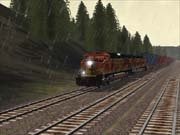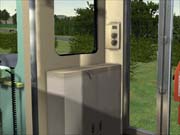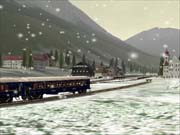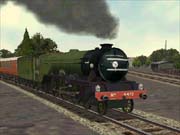As odd as it might sound, railroads are romantic. They offer magical views as they wind through rugged mountains while hugging high cliff sides or roll through misty valleys at dawn. They call to mind bygone eras: steam locomotives rattling over wooden bridges in the Old West as they carried precious silver and gold from the mountains or passenger trains bringing GIs back to their sweethearts after World War II. Even today, the sheer size and massive power of locomotives can evoke the same type of awe that powerful planes and race cars can. And while there are plenty of racing and flight sims, the only train games available so far have focused on strategic empire building. In Train Simulator, Microsoft has created a realistic simulation of the iron horse--one that can hold its head high next to its racing and flying peers.

Train Simulator puts you in the cab and in control of six different railway routes, covering more than 600 miles of track. Thanks to the developer's partnerships with the railways featured in the game, you'll get accurate presentations of both the terrain and the locomotives. Each cab view features animated controls and readouts that you'd find on the real-life counterparts. For the hard-core train enthusiast, you'll be able to operate the dynamic brakes, locomotive brakes, and train brakes separately. You can sound the horns, whistles, and bells at crossings, turn windshield wipers and headlights on and off, and operate sanders to increase the wheel grip on slippery rails. On steam trains, you can change the coal-shoveling rate, open and close the firebox doors, and increase and decrease the injector flow and blowers. Numerous other detailed control options are at your disposal.
If all that sounds a bit daunting, an extensive manual with illustrations and definitions clarifies things, and an online help system and a number of tutorials will also ease you into the game. A reference card lists your controls, as well as the unique track signage of each line, which you'll want to obey to avoid nasty derailments or time penalties when working against the clock. If you'd like to keep things simple, there are driving aids, such as track monitors and a heads-up display, as well as realism options that can reduce controls to just a few keys for a stress-free ride.

You'll experience the great diversity of railroading through the varied routes and engines at your disposal. Train Simulator covers freight and passenger lines, both historic and contemporary. Amtrak's high-speed rail service in the Northeast Corridor gives you a taste of a bustling American commuter line. The Odakyu Electric Railway takes you through the heart of urban Japan. In Japan, you'll also visit the island of Kyushu via the scenic Hisatsu Line of the Kyushu Railway Company. Back in America, you can haul massive freight trains through the Marias Pass in Montana for Burlington Northern and Santa Fe, one of the biggest freight carriers in the world. If you want old-world luxury, head back to the 1920s and take the Venice Simplon-Orient-Express through the Alps. During the same era, you'll dash across the English countryside in the famous Flying Scotsman. Included editors let you alter the routes or create your own.
In the contemporary era, you'll control the Dash 9, GP38-2, and KIHA 31 diesel locomotives, as well as the Odakyu 2000 and 7000 LSE series electric engines and Amtrak's Acela Express and Acela HHP-8 electrics. On the historic lines, you'll control the Flying Scotsman and Gölsdorf Series 380 steam locomotives. While that's certainly a decent selection, it doesn't fully capture the huge diversity of locomotives that have been produced since railroading began. Many rail fans will undoubtedly wish for favorites such as the gargantuan "Big Boy" steam locomotive, the sleek J Class, the tiny narrow-gauge locomotives of Colorado and Maine, the classic F7 diesel--the list can go on and on. While you can alter the interior cab views of the trains, including the control layouts, the editing programs don't let you import or create completely new locomotives, which reduces replay value.
Still, because of the different types of routes and engines that have been included, there's plenty to do. Because the routes are so long and colorful, even the basic exploration mode, where you just ride to your heart's content, offers a lot of enjoyment. When you're ready to get into the meat of the sim, you can tackle various activities that model realistic railroad operations. You can try to stick to a very tight schedule as you load and unload passengers at multiple stations, manage a freight train through bad weather, and conduct complex switching operations in freight yards. In the switching operations, you need to get the right cars from different rail sidings coupled to your train in the right order, which is no easy feat in a large yard with lots of mixed cars. You can also create your own activities. The numerous optional drivers' aids, like a control for the switches immediately in front of and behind your train, help in these tasks, though there's inexplicably no overall detailed track diagram for each route to help you. Also, you can't leap to specific points on each route--instead, you have to start at a number of set stations.

Train Simulator does a superb job bringing the unique sights of the railroads to life. With variable weather and time settings, you'll see trains streak through the night and pass through snow flurries or rain. Each train is carefully and pleasingly detailed. External animated parts add to the authenticity: the pantograph, which draws power from overhead lines to the electric trains, extends and retracts, and the intricate driver rods on the steam locomotives pump in elaborate patterns. And steam and smoke will drift backward in the wind as you pick up speed.
The countryside and trackside buildings provide plenty of detailed, memorable scenery, from deer crossing the tracks to tiny churches high in the Alps. Most impressively, mountains actually look to scale, which is a rare feat in games. The Alps really do seem to dwarf your train. You get the same sense of unusually realistic scale when passing through the urban areas, like Philadelphia or Shinjuku. Some texture seams and draw-in occasionally mar the visuals, but they're infrequent enough to ignore easily. You can view the action from a number of external and internal views, including from within passenger cars. From there, though, you'll notice that the game is oddly devoid of any people. Even some static bitmaps at stations would have been nice. The inclusion of animated automobiles on trackside roads helps make up for that omission, though.

The sounds of the game are almost a match for the graphics. You'll really feel the power and weight of the locomotives from the engine noises alone, at least inside the cab. Outside, the trains are far too quiet. The shrill whistles of the steam engines and the blaring horns and insistent bells of the diesels and electrics are a treat for the train lover. Subtle touches, like the sound of a piano in an elegant passenger car of the Orient-Express, also add to the immersion.
Train Simulator will be a joy for anyone with even a passing interest in trains. The ability to engage in realistic railroad operations and create new routes should appeal to rail fans and model railroaders alike. At the same time, the subject matter imposes some limitations that may not appeal as much to other gamers, at least at first. You won't find the thrilling danger of racing sims or the sheer freedom of flight sims. On the other hand, you will find a finely crafted, meticulous, and often beautiful re-creation of some very colorful trains and railways, with depth to satisfy a hard-core player and simplicity that lets you just enjoy the ride.



